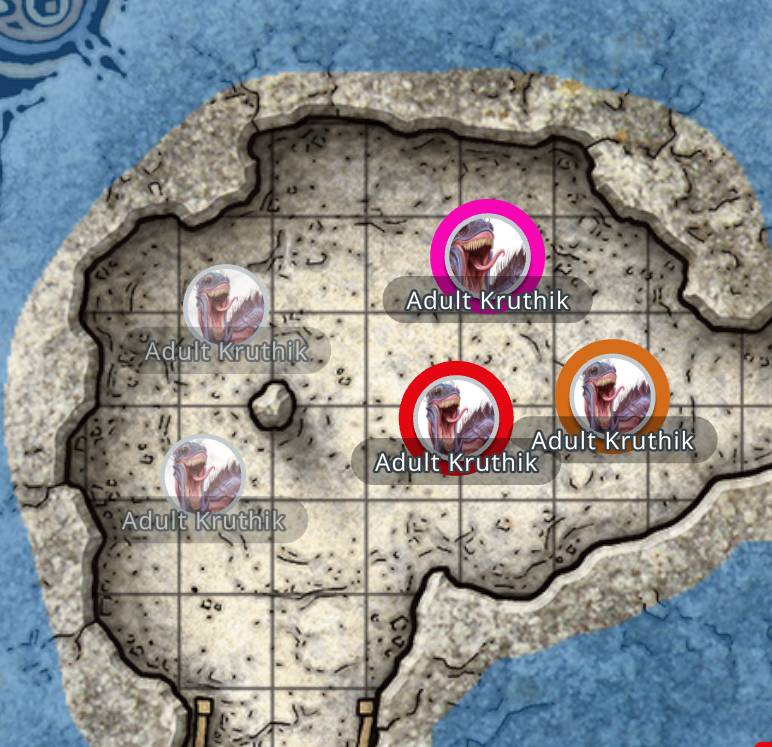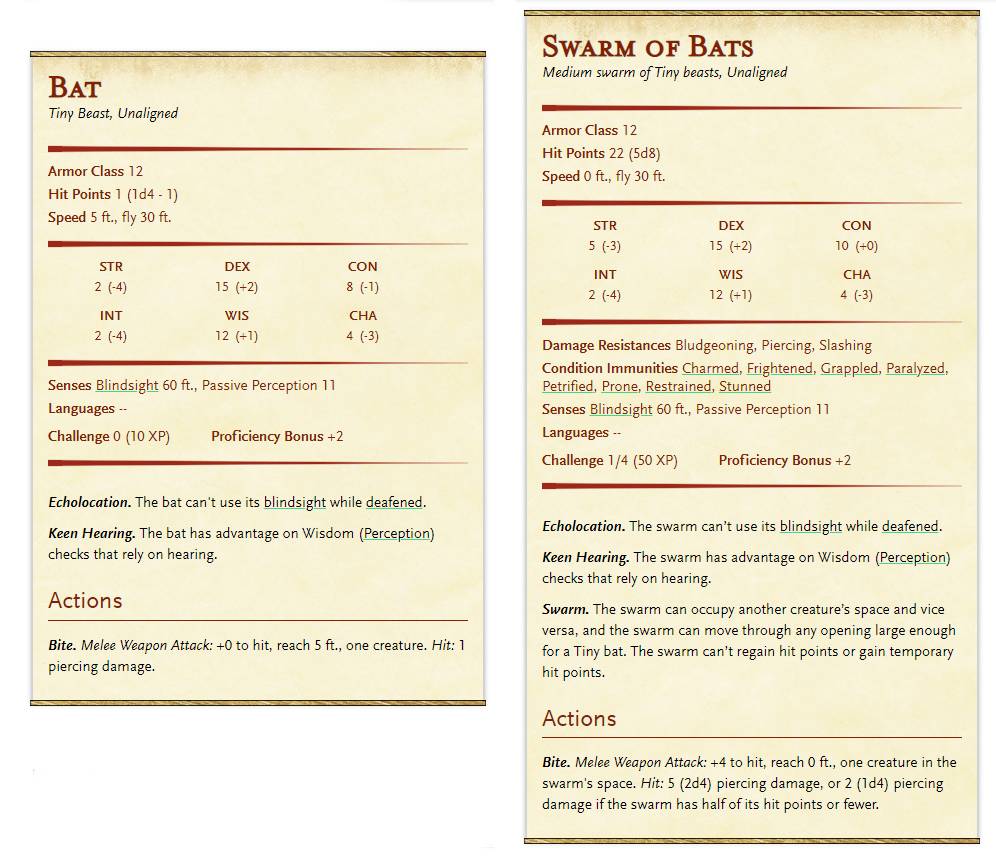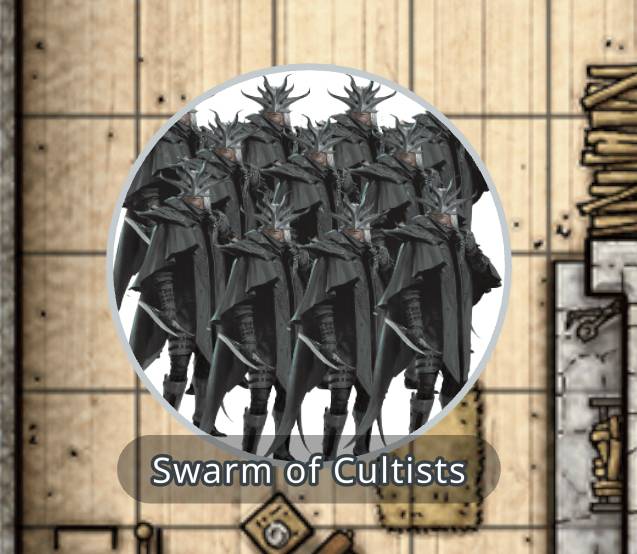The protagonists stand on a bluff, overlooking countless enemies clashing their swords below in a display of power through incalculable numbers. They look to each other, nod, and dive into the fray, plunging head-first into a sea of death and destruction.
There is nothing more cinematic than the heroes facing down an enemy that vastly outnumbers them. But how do you bring this drama and action to D&D without falling to the sheer weight of numbers yourself?
In this article, I’ll cover three different approaches to horde combat so you can use overwhelming forces without being overwhelmed!
A Handful of Hints for Handling Hordes
- It’s easier to use a small selection of moderately complex stat blocks than a lot of different simple ones.
- Use average hit points and average damage.
- The Mob Attacks table from chapter 8 of the Dungeon Master’s Guide can speed up combat.
- Recycle tokens by hiding them or moving them off the map when they’re killed rather than deleting them.
- Use waves of enemies to give your players a breather and avoid combat becoming monotonous.
Reuse, Repair, Recycle
When running an encounter with lots of enemies, it’s very easy to get bogged down with all the tokens or minis you might be using, especially when it comes to tracking which lich is which.
In order to mitigate this, I prefer to use a smaller number of tokens and cycle them in and out, reusing them throughout the encounter. I’m going to explain this using Maps, which is an official VTT, but the principle applies much the same way when using physical tokens or minis.
When you place a token on the map, it’s visible to the players as long as three things are true:
- The session is active
- The token is set to visible
- The token isn’t in a fog of war area
When initially placing tokens for an encounter, you can use the visibility option to hide them from your players until you’re ready to start the encounter.
While hidden this way, you can still interact with them, allowing you to also set the border color option, which is the next key step in tracking lots of monsters. By giving each monster a unique border color, you can more easily track which ones have taken damage.

When a monster is killed, you have two options: Set its visibility to hidden or move it into an area concealed by the fog of war. I like to do the latter because it’s quick and serves as a reminder that it’s a monster token waiting to be reused on the next wave.
Once I move a token into a concealed area, I’ll also remove the border color, so I know it’s ready to be re-used.

You can even use the Draw feature to create pens where you corral your tokens ready to be reused.
Everything is a Swarm
If you want to cut down your tokens without cutting down your monsters (you can leave that to your players), swarms can be the way to go. A swarm represents a cluster of the same type of monster acting as a single horde and are very flexible. You can have anything be a swarm, from bats to rats to skeletons to animated books. But how do you go about converting a monster of choice into a swarm? Let’s look at the difference between a monster and its swarm version to see what changes we need to make.
We’ll use the bat and swarm of bats stat blocks and compare their main differences:

If we compare the stat blocks, we can see the following differences:
- The size category increases by two—from Tiny to Medium
- The hit die goes from a d4 to a d8. This is because hit dice for monsters are tied to size category: d4 for Tiny and d8 for Medium.
- The swarm gains resistance to Bludgeoning, Piercing, and Slashing damage and also gains immunity to a number of conditions that would make sense to affect a single monster but not multiple.
- It gains the Swarm trait, which allows it to occupy the same space as another creature, move through any space big enough for a singular bat, and also cannot regain Hit Points.
- Its attack can only target creatures occupying the same space as it and does more damage. However, the damage is halved if the swarm is below half its starting Hit Points.
With that in mind, if you want to convert an existing monster into a swarm, here is what I would recommend. Note that simpler monsters, without special traits or too many attacks, generally work better as swarms:
- Increase the monster’s size category by one or two sizes.
- Increase its Hit Dice to match its new size category. Hit Dice scale as follows:
- Tiny - d4
- Small - d6
- Medium - d8
- Large - d10
- Huge - d12
- Gargantuan - d20
- Give it resistance to Bludgeoning, Piercing, and Slashing damage and immunity to the following conditions: Charmed, Frightened, Grappled, Paralyzed, Petrified, Prone, Restrained, and Stunned.
- Give it the Swarm trait: Swarm. The swarm can occupy another creature’s space and vice versa, and the swarm can move through any opening large enough for a [original monster]. The swarm can’t regain Hit points or gain Temporary Hit Points.
- Increase the damage of its attacks by up to 50%, but reduce the reach to 0 feet, seeing as the swarm can only target creatures it’s sharing a space with. The swarm also does half damage if it has fewer than half of its starting Hit Points
- Increase its CR by 2 due to having increased Hit Points and damage output.
- Finally, and optionally, make some sweet custom art using your image editor of choice.

Bring Me My Minions
My third piece of advice for using large numbers of monsters effectively and with as little hassle as possible is a callback to the fourth edition of D&D: minions.
Minions were a special class of monsters that hit a little harder, had stronger defenses, and didn’t take damage from missed attacks or successful saves, but only had a single Hit Point. This meant you could throw dozens of them at your players, and they’d simply cut through them like a flame tongue sword through butter.
Minions don’t really exist in D&D fifth edition, but it’s not too hard to concoct a template to turn a monster into a minion. Much like swarms, this generally works better for simpler monsters without complicated features or lots of attacks.
- The monster gets a +2 to AC, attack rolls, damage rolls, and saving throws.
- The monster has a version of the Evasion trait: Evasion. If the [monster name] is subjected to an effect that allows it to make a saving throw to take only half damage, the [monster] instead takes no damage if it succeeds on the saving throw.
- Most importantly, the monster has 1 Hit Point. It also loses any damage resistances or immunities.
With this, you should have a monster that you can use in massive waves that won’t bog you down with tracking Hit Points. Minions don’t even have to hit with their attacks or even make an attack; their sheer numbers can be a challenge in its own right.
Use Optional Rules for Cleaving
Minions work exceptionally well with one of my favorite optional rules from the Dungeon Master’s Guide: Cleave through Creatures.
This rule found in chapter 9 allows a creature to carry excess damage from a melee attack that kills a creature over to another creature. When you have minions, this can mean the players are racking up a serious number of downed enemies on their turn and allows each minion to function almost like a single Hit Point on a bigger monster.
This rule is also great for giving martial characters that extra something special if you feel they need it.
Mass Monster Round-Up
So there you have it, my three tricks to running a veritable creature cornucopia using various tools such as Maps, homebrew, and optional rules in the Dungeon Master’s Guide. With these tricks you can up the scale of your combat encounters. However, as tempting as it can be to run an army of monsters, there are some important things to remember:
- Having lots of creatures can slow down initiative, so in addition to using the mob rules, don’t forget to use the initiative rule, where you make a single initiative roll for identical creatures, and they act at the same time.
- The more creatures you have attacking the players, the more likely things like Critical Hits and conditions become. As such, use creatures that are weaker than you’d normally pick. You can always add more waves later in the combat.
- When it comes to balancing encounters, especially when using lots of monsters, it’s generally better to aim low in terms of difficulty and increase it on the fly than the other way around. It’s easier to come back from a too-easy encounter than a too-hard one.

Davyd is a moderator for D&D Beyond. A Dungeon Master of over fifteen years, he enjoys Marvel movies, writing, and of course running D&D for his friends and family, including his wife Steph and his daughter Willow (well, one day). They live with their two cats Khatleesi and Mollie in the south of England.








-
View User Profile
-
Send Message
Posted May 25, 2024I try to avoid horde battles whenever possible, but sometimes the players make it inevitable. Hopefully this will help with future encounters.
-
View User Profile
-
Send Message
Posted May 25, 2024Great article, thank you for this!
-
View User Profile
-
Send Message
Posted May 26, 2024I think that's just called the DMG 😂😂😂 ( kidding )
-
View User Profile
-
Send Message
Posted May 26, 2024for hordes i use Warhammer's tactics of rolling multi d6's. hitting on rolls of 4 or higher. Advantage, disadvantage, bless, & bane can increase or decrease chance to hit.
-
View User Profile
-
Send Message
Posted May 26, 2024I thought minions were great but I really miss Skill Challenges! In fact, as of yesterday they are back in my game, baby! ( : Matt Colville had a great video about this.
Great article by the way, I've always wanted to pit the party against a never ending wave of zombies. This gives me some ideas on how to do so.
-
View User Profile
-
Send Message
Posted May 26, 2024I really wanted to include my old frozen wastes outpost map I used for a zombie hoard encounter a few years back, but couldn't find the notes. I basically gave the PCs time to reinforce the outpost with various bits of furniture, using the object AC/HP rules. They ended up falling back through the outpost as doors broke down and windows shattered. It was a blast and a great use of both the minion and cleave rules.
-
View User Profile
-
Send Message
Posted May 27, 2024I'm going to be running a homebrew game in about a month, and I definitely want to use hordes. I mentioned this to a player who liked the idea but was concerned that only casters would be able to claim the spotlight due to their wide array of AOE spells. Now that I've read this article, I can safely add hordes of enemies while giving melee characters a chance to shine. Thanks, Davyd!
-
View User Profile
-
Send Message
Posted May 27, 2024I hd my PCs invade “the evil empire” as end of Tier 1… tier 2 and tier 3 would also have their “overlord”…
And I did it as you describe, their mission was to go for the main target (the queen and its direct officials) while describe the background, and have them move troops in a “theater of the mind styles” with the add that they would see troops of both size moving in the background.
BUT i kind of want to start playing with that scene that the article opens with; using the “minions” rules from “flea, mortals” and it worked great so far… i think. But kind of want to try the swarm idea, no sure it ll work as well or that i would like it as much as the minion idea, but it might be cool to try.
-
View User Profile
-
Send Message
Posted May 27, 2024I just tried using these rules and the DMG to run a horde battle, and not only did my players get bored, argue with my dm rulings, and all around act like d**ks, but I also couldn't keep track of the monster's hp.
0/10 would not recommend. :(
-
View User Profile
-
Send Message
Posted May 28, 2024Awesome. My players are constantly getting into fights when the whole bad guys crew is around or try to have a bunch of hirelings with them to fight to or something that evolved into some massive fight
-
View User Profile
-
Send Message
Posted May 28, 2024It's not intended to be a fix, but a tool.
As for action economy and attacks, Multiattack can mitigate that if you feel the stat block needs more attacks, and being more vulnerable to single attacks is actually a boon to martial characters (unless you're already using the Cleave optional rule)
-
View User Profile
-
Send Message
Posted May 28, 2024Not every style of encounter is for every group, that's true. My players love big hoard battles every now and again, usually as some kind of set piece. It's difficult picking the right moment, totally agree.
-
View User Profile
-
Send Message
Posted May 28, 2024If you're in theater of the mind, you can use this tool I coded: https://abelhawk.github.io/DnD/Calc/calc.html
Super handy and I use it all the time.
-
View User Profile
-
Send Message
Posted May 28, 2024Awesome article! I would love a series of articles like this helping DMs with niche rules that may be covered in the DMG or other books, but are often overlooked or forgotten about!
-
View User Profile
-
Send Message
Posted May 28, 2024Great article that helps DMs in their time of need. Thank you.
-
View User Profile
-
Send Message
Posted May 28, 2024They also have different minion rules which are much better. But I assume there is some contract stuff that won't allow them to share those minion rules.
-
View User Profile
-
Send Message
Posted May 28, 2024I am really glad someone official is looking at this as it is something really needed in 5e. With that said, I do prefer my own minion rules.
I found this allows for me as the DM to put more enemies on the field that are not threatening individually, but something PCs can't afford to allow to group up. All of my players feel like heroes taking down groups of enemies. Doing the automatic hits greatly improves turns by not needing to do attack, damage, or saving throw rolls. It also allows me to scale encounters a little more dynamically with the number of minions I want to add.
The only balance thing I would have to look at is perhaps allowing to add proficiency to the Stat modifier around level 10 to clear more minions. I also skewed minion clearing toward martial classes because most spell casters have some access AOE spells. I currently have EB as the exception because low to mid-level Warlocks didn't have the spell slots or the number of cantrips to deal minions compared to martials or full spell casters.
-
View User Profile
-
Send Message
Posted May 29, 2024Great article!
-
View User Profile
-
Send Message
Posted May 29, 2024Hmmmmmm ;)
-
View User Profile
-
Send Message
Posted May 29, 2024When adding new tokens to the map while the session is active, it would be real nice if they started hidden, and then you could enable them as needed. Right now I have to pause the session, add the tokens, hide them, then unpause the session. Otherwise they'll briefly see the token appear. I'd prefer to be able to slip them in already hidden while the players are discussing the next round of play with the map visible.